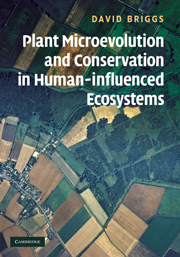Book contents
- Frontmatter
- Contents
- Preface
- Acknowledgements
- List of abbreviations
- 1 Introduction
- 2 Studying change
- 3 Key concepts in plant evolution
- 4 The origin and extent of human-influenced ecosystems
- 5 Consequences of human influences on the biosphere
- 6 Categories
- 7 Investigating microevolution in plants in anthropogenic ecosystems
- 8 Plant microevolution in managed grassland ecosystems
- 9 Harvesting crops: arable and forestry
- 10 Pollution and microevolutionary change
- 11 Introduced plants
- 12 Endangered species: investigating the extinction process at the population level
- 13 Hybridisation and speciation in anthropogenically influenced ecosystems
- 14 Ex situ conservation
- 15 In situ conservation: within and outside reserves
- 16 Creative conservation through restoration and reintroduction
- 17 Reserves in the landscape
- 18 Climate change
- 19 Microevolution and climate change
- 20 The implications of climate change for the theory and practice of conservation
- 21 Overview
- References
- Index
7 - Investigating microevolution in plants in anthropogenic ecosystems
Published online by Cambridge University Press: 05 June 2012
- Frontmatter
- Contents
- Preface
- Acknowledgements
- List of abbreviations
- 1 Introduction
- 2 Studying change
- 3 Key concepts in plant evolution
- 4 The origin and extent of human-influenced ecosystems
- 5 Consequences of human influences on the biosphere
- 6 Categories
- 7 Investigating microevolution in plants in anthropogenic ecosystems
- 8 Plant microevolution in managed grassland ecosystems
- 9 Harvesting crops: arable and forestry
- 10 Pollution and microevolutionary change
- 11 Introduced plants
- 12 Endangered species: investigating the extinction process at the population level
- 13 Hybridisation and speciation in anthropogenically influenced ecosystems
- 14 Ex situ conservation
- 15 In situ conservation: within and outside reserves
- 16 Creative conservation through restoration and reintroduction
- 17 Reserves in the landscape
- 18 Climate change
- 19 Microevolution and climate change
- 20 The implications of climate change for the theory and practice of conservation
- 21 Overview
- References
- Index
Summary
Earlier chapters have been designed to serve particular purposes. Chapter 3 provides a connected overview of the concepts underlying our current understanding of the long history of plant evolution. Chapter 4 reveals that while on a geological time scale, humankind arrived on the scene relatively recently, human impacts on the Earth's ecosystems have been very dramatic and are destined to increase. Examples of the effects of human activities on ecosystems are all around us, and it could be claimed that such interactions are so obvious they hardly need to be documented. However, as we have seen above, evidence suggests that the cumulative impact of human activities on the biosphere, both directly and at a distance, have often been underestimated. Also, the full complexity of the interactions of plants and humans is becoming evident, resulting in the recognition of many different categories. For the convenience of devising helpful groups, a species may often be classified in different categories according to the circumstances (Chapter 6).
In total, there have been many thousands of published papers of different facets of plant evolution. Some have investigated the early evolution of plants and animals, others have examined the patterns and processes that have generated, through time, the millions of species that live on Earth.
- Type
- Chapter
- Information
- Publisher: Cambridge University PressPrint publication year: 2009



